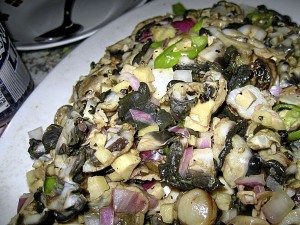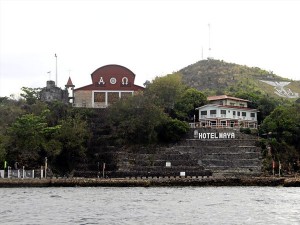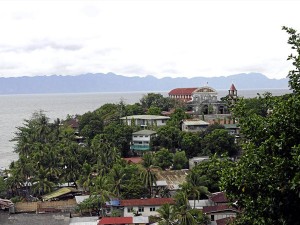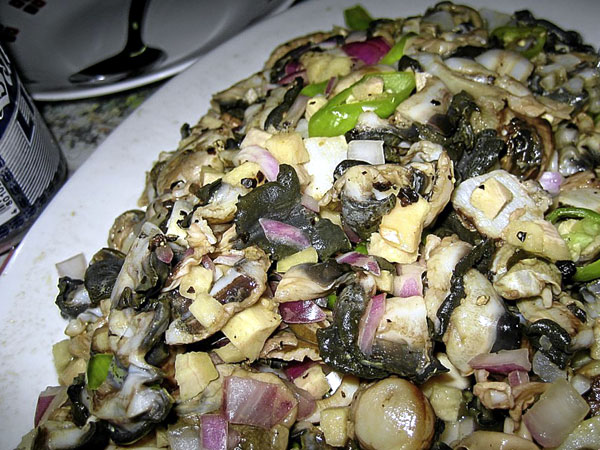
I still have a delicious caramel tan from my trip to Isla Culion, Palawan.
For nearly nine decades, the island was the designated home of the country’s leper patients. But with leprosy now treatable at home, the island has embarked on a new chapter as a tourism destination. Still, most people get fixated on the island’s past and have failed to appreciate its location. Culion is blessed to be part of the Calamianes Group of Islands, a 90-minute boat ride from Coron and not too far away from the posh El Nido resorts.
After an hour-long plane ride, a 25-minute van ride, and a 90-minute boat ride (plus 30 minutes or so because of delays at the pier), you are rewarded with a cozy undiscovered town. It helps that my friend Nilda and I were visiting one of the two Jesuits assigned to the island, Fr. Xavier Alpasa, SJ.
There’s no denying the town’s strong Catholic faith. Approaching Culion, you can’t miss the bright red Our Lady of Immaculate Conception Church perched on the cliff. Next to it are large white letters, much like the iconic Hollywood sign, that read HOTEL MAYA, the social enterprise hotel recently established by the Jesuits.

After my stint in Singapore and Hong Kong for the past few years, I was looking forward to soaking up the islands. Culion did not disappoint with its diverse natural attractions: a lookout point in Pulang Lupa more breathtaking than Tagaytay’s vistas, the best view of the islands up 333 steps high in Aguila, experiencing a wrecked ship’s beauty in Lusong Gunpoint, and rich underwater life at Bodor Marine Sanctuary. I warmed up in the hidden hot springs few boatmen knew about and cooled down in the white sand beach of Malcapuya.
While finding Culion’s beauty was easy, my journey in discovering the island’s culinary scene was not as simple. Famished from our long voyage from Manila, we wolfed down the dinner set before us at Hotel Maya. It was Fish Meuniere with Eggplant & Grated Squash Fritters. We wiped our plates clean, as we had missed lunch earlier. The hotel staff could barely pronounce or spell Meuniere, a French word for dredging the fish in flour and serving it with a brown butter, lemon and parsley sauce. While its execution was fair, the last thing I want to eat in the islands is a Western dish. I was craving for a comforting local dish to give me an authentic taste of Culion.
Before hitting the sack, the server asked what we wanted for breakfast the next day. I surveyed the list of 11 options: Pancakes, Oatmeal, Eggs Benedict, the list goes on. I was intrigued by Bolpen, described in the menu as Culion Seasonal Dried Fish served with rice and vegetable tapa. The server said they would try to buy some from the market, “maybe tomorrow.” Tomorrow came and the next day and still no bolpen. Fortunately, the kind priest eased our curiosity by frying some of the bolpen he had at the Jesuit residence. These dried squid are only about 2 inches long. When fried, they achieve a perfect crisp texture difficult to achieve with the larger varieties of dried squid. Bolpen is great for breakfast but is an ideal match for an ice-cold beer, while watching Culion’s glorious sunsets.
Despite the hotel’s six-page menu, many of the dishes were not available. Aside from the bolpen shortage, squid, crabs, and mangoes were hard to come by. The island only has 12 hours of electricity, meaning fresh ingredients risk spoilage without refrigeration. The offerings included: Pasta Alfredo, Monte Cristo, Calamare with Melanzani Fungheto, and variations of cream soups from pumpkin to bell pepper.
After the disappointing morning date with two cold poached eggs mistakenly baptized as Eggs Benedict in the menu, I gently confessed my culinary woes to the priest. While the fried fish and Pinakbet and Fish Steak with Chopsuey were soothing lutong bahay (home-cooked) dishes, I longed for food showcasing the bounty of the sea. No beach holiday for me is complete without Inihaw na Isda or Inihaw na Pusit (grilled fish or squid). It is utterly enjoyable to dig into the char-grilled goodness of the sea with saltwater still dripping off your hair and body after a swim.

On my last day on the island, we impulsively decided to stage a sumptuous picnic in Malcapuya Island, Culion’s best white sand beach. Tired of hearing about the shortage of ingredients, I decided to take matters into my own hands and headed off to market bright and early, along with Toto of Hotel Maya. I expected to see a proper market brimming with ingredients but saw only a talipapa (small market) with three vendors. My mission was to buy fresh crabs, fish, vegetables and fruits, but there were no crabs in sight.
I was told we were too early and that seafood was often brought directly to Coron. So I settled for some vegetables that I would cook in coconut cream. There were three vendors selling tulingan (mackerel) and tambacol weighing two kilos or more, but they were a bit much for our party of seven. We walked home empty-handed. Luckily, as we neared the hotel, the fish delivery arrived and later, we had fish cooked bistek style. Without crabs, we had no choice but to ask the hotel cook, Nanay Rosing, to whip up a fool-proof dish, chicken adobo.
Three hours later, I wandered about town in a tricycle and found a pail of fish crabs. “Alimango!” I screamed, startling the tricycle driver and a female passenger. We stopped and I asked the pregnant Tagbanua lady holding the pail of crabs and the little boy with her to join us in the tricycle. They had no weighing scale, so I decided to take them back to Hotel Maya to close the deal. The crabs put up a fight as we weighed them. Two and a half kilos, the scale read. At only P120 per kilo, the four crabs were a steal at P300. At last, with the waves crashing, our hair windblown and our smiles uncontrollable, we said grace and ate our best meal in Culion for lunch.
Later in the evening, Fr. Javi invited us to join a celebration of the newly crowned Mutya ng Culion. The pageant winner’s mother was one of the island’s best cooks. Close to the old St. Paul’s Convent, some 30 steep steps up from the road, lies her home and secret restaurant. Tourists come here just to eat. She had grilled tambacol, with a special dipping sauce of soy, onions, and chili. I finally got my dream of eating grilled fish.
Before leaving the island, Fr. Javi asked me to meet with the hotel’s kitchen staff. With my Master’s Degree in Gastronomy, experience as a food stylist, and 13 years in food and travel writing, plus working with food in various capacities, there was much I could contribute. I gave my detailed feedback on the meals. I found the western menu problematic. It required using ingredients not readily available on the island. While I recognized their desire to impress guests with international fare, it was just not a match. I had observed that the other Filipino guests had always ordered from the menu the few Filipino dishes they were familiar with. The servers admitted they could barely pronounce the names of the dishes, or explain them to the diners. It was not meaningful food for the kitchen staff or the hotel patrons. I asked Nanay Rosing and her team, “What dishes would you be proud to serve?” She looked down to the pebbled ground, almost embarrassed to admit that Fish Meuniere meant nothing to her.
All my years in the kitchen taught me this. When the ingredients inspire the cook, you can taste it in the dish. Her rendition of guinataang gulay (veggies stewed in coconut cream) for our picnic was excellent. Her version of ginisang bagoong (sauteed shrimp paste) was chunky and perfectly seasoned with a salty sweet punch. It was so good we ate it with the Indian mangoes, green mangoes, and even rice. Her chicken adobo was quite delicious, too. She agreed with my desire to make the menu more in tune with locally available ingredients and palates. She suggested dishes like Pinangat Sa Kamias (fish stewed in kamias, a local souring fruit agent). Fr Javi later told me how glowing reviews on Nanay Rosing’s Pancit Canton have been spreading to Coron. Island tours now stop by Culion for a taste of her take on this classic noodle dish.
Yes, it is baffling how Culion, so rich in seafood, could have such a limited supply of fish, squid or crab. The worldwide trend in gastronomy these days is to source local food, with ingredients grown and produced just meters away from the restaurant. This equates to serving food that is fresh and at its prime. If the ingredients do not travel a long way from the food source to the consumer’s mouth, it means lower costs and a lower carbon footprint because of less fuel used to tranport them. It is a win-win situation to go local. Most importantly, it is a great way to proudly showcase to the visitors the region’s local culinary heritage.
Cuyo is the former capital of Palawan. Its residents, the Cuyonons are experts in cooking shell fish of various shapes and sizes. In Culion, they have the Sikad, Talaba sa Bakawan, Sigukguk and Suliot. As we reached the seaside from a day of island-hopping, we saw a Tagbanua woman holding several garlands of Suliot. Before I could even utter the tongue twister, “She sells seashells by the seashore,” Fr. Javi excitedly purchased her wares for only P120. The shellfish meat had been extracted from their shells and were now strung into a garland much like the sampaguita lei given to celebrities. Nanay Rosing expertly turned the Suliot to adobo and a kinilaw (ceviche) with lots of onions and garlic. Only seasoned cooks know how to cook these shellfish, keeping the meat tender. Overcooking toughens the meat and turns it rubbery. I prefer the kinilaw’s refreshing flavor, while the priest liked the adobo better.
Why do we have to resort to fancy western dishes when Palawan cuisine has its own clever spin on dishes, what with the diversity of ethnic groups ensuring many creative ways with food? The Palaweños add cucumber to Kinilaw na Tanigue, adding a refreshing crunch to the fish cooked in vinegar. For their tinolang manok, the islanders add lemongrass for flavor. The fresh bounty of the sea yields lato (seaweeds), sea urchins and sea cucumbers. Sinigang na Isda (fish in sour broth) is soured not by tamarind, but green mangoes cut up, boiled and mashed in the broth.
With Fr. Javi’s blessings, I highly recommended removing many Western dishes from the menu and replacing them with authentic Palawan cuisine. My suggestion was greeted with sighs of relief from the staff.
Before leaving the island, I challenged Nanay Rosing to cook dishes she would be proud of. On my end, I promised to help revise their menu to better showcase the local delicacies of the island. I did not come all this way to Palawan to eat corned beef from a can or poached eggs or any fancy western dishes. I emphasized the need for the food to be fresh, delicious, and cooked in the local style.
At 6 a.m., Nanay sent us off on our long journey back to Manila with a packed lunch of her famous adobo and fish steaks to eat along the way. She wore a bright red lipstick, meriting a gentle ribbing from Fr. Javi: “Aalis lang si Maida, nag-lipstick ka na (So Maida leaves and you put on lipstick).” For the first time, the cook smiled, stood tall and confident. I too was happy. Nanay Rosing had just begun her journey to find her own culinary heritage. I can’t wait to head back to Culion for a feast of authentic Palawan cooking. •
For more golden delicious moments in food and travel, join Maida at www.themaidastouch.blogspot.com








































